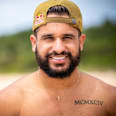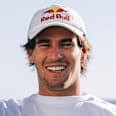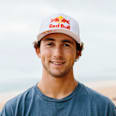
Surfing
From Big Wave to the Longboard Tour, the World Juniors to the Championship Tour and all points in between, here's your cheat notes for everything you'll ever need to know about the World Surf League.
01
What is the WSL?
The World Surf League (WSL) is a beast. Roughly 1,000 surfers around the world battle it out in WSL events every year, across the four tiers of shortboard competition, and on the Longboarding and Big Wave Tours.
Starting with the Junior and Qualifying Series, run across seven global regions, surfers progress to the Challenger Series and, hopefully, the biggest stage of them all – the Championship Tour. This decides the world champions. How does it all work? Let's take a look.
Watch the World Surf League Championship Tour on Red Bull TV – streaming on web browsers, mobile apps, and Smart TVs.
02
How do surfers qualify for the WSL tours?
There are three tiers of shortboard competition on the WSL, the Qualifying Series (QS), the Challenger Series (CS) and the Championship Tour (CT). Any surfer who's paid an annual World Surf League membership can enter Qualifying Series events. These can be relatively small affairs with less than 50 people competing, up to larger events with 100-plus fighting it out for points. These are ranked from QS1000 to QS5000, depending on the quality of wave and size of the prize pool. The bigger the event, the more points you can win.
Surfers who earn enough points in their region over the course of a QS season graduate to the next tier, the Challenger Series. The CS is the stepping stone to the highest echelon, the Championship Tour.
Each Challenger Series event currently sees 80 men and 48 women compete. These numbers comprise 49 men and 30 women who've qualified through the seven WSL regions (Australia/Oceania, Asia, Africa, Europe, Hawaii/Tahiti Nui, North America and South America). As well, there are the two World Junior Champions from the previous year and a long list of surfers who missed the cut on the Championship Tour that year, or were highly ranked the previous year in the Challenger Series.
Finish in the Top 10 of the men's CS or the Top 5 of the ladies' CS and you've qualified for the Championship Tour! The CT comprises 32 men and 16 women and every event also welcomes wildcards – four male and two female.
At season's end, the top five men and women on the Championship Tour surf in the WSL Finals, a one day event that determines that year's world champions.
03
Can I become a WSL surfer?
Yes! Anyone can sign up. Once you've paid your annual membership fees, you're welcome to enter Qualifying Series events around the world, though you can only earn points towards making the Challenger Series in your home region.
04
How many surfers compete on the WSL?
There are thousands of surfers competing on the Qualifying Series in the seven WSL regions, with events held in countries as far flung as Canada, India, Peru and South Korea.
Every year, 80 men and 48 women graduate from the QS to compete in the Challenger Series, in an attempt to qualify for the top-level Championship Tour.
The Championship Tour is made up of 34 men and 17 women, with wildcards added at each of the nine events.
05
Who are some famous WSL surfers?
Kelly Slater is unquestionably the greatest surfer of all time, with 11 world titles the icing on an endless list of achievements and an influence on the sport that extends far beyond competition. From pushing surfboard design and wave-pool technology, to environmental work and his status as a full-blown '90s celebrity, Slater is a global athlete often mentioned in the same breath as icons such as basketball player Michael Jordan, golfer Tiger Woods and NFL player Tom Brady.
Andy Irons gained fame around the world as the first surfer to genuinely challenge Slater, claiming three-straight world titles in a sizzling run from 2002-2004, and making such an impact in his tragically short life that the Governor of Hawaii decreed February 13 to be known as Andy Irons Day. A similar honor was bestowed upon fellow Hawaiian world champion Carissa Moore, her five women's world titles resulting in January 4 being named Carissa Moore Day.
Gabriel Medina, who became Brazil's first world champion in 2014 and has since won two more titles, is a megastar in his homeland. Often seen the cover of national newspapers and magazines, and with over 14m Instagram followers, Medina's celebrity is on a par with his country's most celebrated football players (as long as they're not named 'Neymar').
Mick Fanning is an Australian celebrity of the highest order thanks to winning three world titles in the face of family tragedy and his encounter with a great white shark while surfing the final of the J-Bay Open in 2015. Eight-time world champion Stephanie Gilmore and seven-time world champion Layne Beachley are also incredibly well-known figures in their homeland.
While maybe not global celebrities, surfers like Japan's Kanoa Igarashi and Portugal's Frederico Morais are huge in their homelands, while Championship Tour surfers Ramzi Boukhiam, from Morocco, and Indonesia's Rio Waida were both national flag bearers at the Tokyo Games.
Who's next? Caity Simmers, Molly Picklum, Griffin Colapinto and Jack Robinson are all teetering on the precipice of global stardom... stay tuned!
06
How do WSL heats work?
On the QS and CS heats are made up of four surfers, with two advancing to the next round, before heats become one-on-one by the finals. On the CT, the opening and elimination rounds see three-surfer heats, with the top two advancing. From then on it's one-on-one until the trophies are given out. Heats run anywhere from 20 to 30 minutes, though time can be added if the conditions call for it.
Individual waves are scored out of 10 points and a surfer's best two waves make up their heat total. Surfers are given right of way to catch waves in an order determined by the priority judge, but there's no limit to the number of waves a surfer can ride.
At the start of the heat there's no priority and once a surfer catches a wave they go to the back of the line and are given second, third or fourth priority, depending on how many surfers are in the heat. If you drop-in on or get in the path of a surfer with a higher priority, the judges may rule an interference against you and penalize you either a half or full wave out of your final score.
While the surfer with first priority will often sit and wait for a good-looking wave, those with lower priority might stay a little busier, rolling the dice on smaller waves and hoping they shape up into something better. Priority can be a surfer's best friend if they're skilled at reading the ocean and can pick the better waves, but being too patient can leave them undone if mother nature doesn't come to the party before time runs out.
Although it takes anywhere from three-to-five days to run an event, due to the fickle nature of waves and weather, anything up to a 12-day window is allowed in competition.
Occasionally on the CT one-on-one heats are run in an overlapping format with two heats in the water simultaneously, offset by half a heat. In these instances heats can be up to 46 minutes long. Upon entering the lineup competitors cede all priority to the pair of competitors who were already in the water, before gaining right of way in the second half, over the new surfers who've just joined them. This might sound complicated, but it's actually a great way to cram more surfing into less time. Kelly Slater came up with this format.
07
How is a WSL heat scored?
Let's look to the WSL Rulebook for a full breakdown.
Surfers must perform to the WSL judging key elements to maximize their scoring potential.
Judges analyze the following major elements when scoring a Ride:
- Commitment and degree of difficulty
- Innovative and progressive maneuvers
- Combination of major maneuvers
- Variety of maneuvers
- Speed, power and flow
It’s important to note that the emphasis of certain elements is contingent upon the location and the conditions on the day, as well as changes of conditions during the day.
A panel of five judges score each wave on a scale of 1-to-10. For every scoring ride, the highest and lowest judged scores fall off and the surfer receives the average of the remaining three scores.
In any round, a surfer is looking to lock-in their two highest-scoring waves. The top single wave score is a 10, for a possible 20-point heat total.
There have been eight Perfect 20 heats in the history of the Championship Tour. Kelly Slater is the only person to achieve this feat three times, while Owen Wright is the only other surfer to do it twice.
Jordy Smith famously surfed a perfect heat at Jeffreys Bay in South Africa in 2017, to the delight of an adoring hometown crowd, but American Shane Beschen can claim ultimate bragging rights. He scored a barely believable Perfect 30 in 1996, back when heats still counted a surfer's best three waves.
08
How does the WSL Mid-Year Cut work?
As the talent levels continue to soar, the WSL has introduced a number of controversial initiatives in recent years, including the Mid-Year Cut – which reduces the number of surfers on the Championship Tour – and the WSL Finals, a one-day event to determine the world champion.
The cut sees the Top 32 men and Top 17 women's fields reduced to a Top 22 and Top 10 for the second half of the season, following the fifth event. Those who fail to make the cut go back to the Challenger Series, which by design starts in the back half of the year.
09
What do the different color WSL jerseys mean?
Surfers are allocated brightly colored jerseys so that judges and competitors can identify them more easily. This is very necessary given the nature of the environment they compete in, a long way out to sea and often shrouded in fog or lost in sun glare.
In recent times, the WSL have introduced a yellow jersey to signify the number one ranked surfer on the Championship Tour at that time. In most other heats the higher-seeded surfer traditionally wears red.
10
What's the WSL 2025 Championship Tour schedule?
There are 11 events on the Championship Tour in 2025, at the end of which the five highest-ranked men and women compete in the one-day WSL Finals, which will take place at the legendary Cloudbreak in Fiji this year, having been held at Lower Trestles in California since the format was first introduced in 2021. The last man and woman standing are then crowned world champions.
11
Who is the current WSL champion?
12
History of the World Surf League
Hawaiian surfers Randy Rarick and Fred Hemmings founded the International Professional Surfers (IPS) in October 1976, in an attempt to bring the world's existing surfing competitions under one umbrella. The nine events that had already been run that year were factored in, as well as a handful more to come and, in January of 1977, 23 year old Australian surfer Peter Townend was crowned the first ever IPS World Champion.
The following year, Hawaiian surfer Margo Oberg was crowned as the first-ever female world champion, alongside South African Shaun Tomson on the men's side. The IPS crowned world champions until 1982, with Australian Mark Richards landing an incredible four-in-a-row from 1979 and Oberg claiming three all up.
13
IPS World Champions
14
The creation of the ASP
In 1983, Australian Ian Cairns created the Association of Surfing Professionals (ASP), convinced his peers to join him, and moved the league's offices to California in pursuit of sponsor dollars. With more events and increased prize money, the ASP experienced strong growth through the '80s and '90s. Like most sports it was a rollercoaster however and the structures and formats of the league has been in a constant state of flux from the start.
The ASP's first Longboarding world champion was crowned in 1986 and the first Junior world title was decided in 1998. As the number of competitive shortboard surfers increased, the tour was split in 1992 and surfers would now have to graduate from the World Qualifying Series before they could chase a world title on the elite World Championship Tour.
In 1999, the ASP moved their head office to Coolangatta on Australia's Gold Coast in order to be closer to the 'Big Three' surf brands: Rip Curl, Quiksilver and Billabong. Under the stewardship of 1978 World Champion Wayne Bartholomew as CEO, the WCT moved to a quality-over-quantity approach and the legendary Dream Tour era was born. This was a golden age for surfing and, with the backing of a booming surf industry, the schedule of events suddenly looked like every surfer's bucket list.
The 1990s also saw the arrival on the scene of a certain Robert Kelly Slater, who won his first world title in 1992 and then five straight between 1993 and 1998. Much like Michael Jordan and basketball or Tony Hawk and skateboarding, Slater becoming a household name boosted surfing's profile as well.
In the early 2000s, surfing's first live webcast landed. The ASP, which was now accessible to surf fans around the world, continued to boom, driven by the fierce rivalry of Kelly Slater and brash Hawaiian Andy Irons. An American consortium, including members of Slater's management, team bought the ASP in 2012 and in 2015 they rebranded.
15
ASP World Champions
16
The World Surf League – surfing's governing body since 2015
The World Surf League (WSL) has been running surfing since the ASP rebranded in 2015. The headquarters moved from Australia back to Santa Monica, California, and the broadcasting of Championship Tour events was taken in-house, amongst other changes.
Most significantly however, between the battles of Carissa Moore, Stephanie Gilmore and Tyler Wright, the introduction of equal prize money, and the recent heavy water performances of Caity Simmers and Molly Picklum it's been an incredible time for the advancement of female surfing.
In 2023, Caroline Marks became the first new female world champ since 2016 and Caity Simmers added her name to the list 12 months later. Molly Picklum is also hellbent on etching her name on surfing's biggest trophy before too long.
On the men's side of things, the 'Brazilian Storm' was upgraded from light rain to a full blown tempest, with Hawaii's John John Florence the only surfer stopping Brazilians Italo Ferreira, Adriano de Souza, Gabriel Medina and Filipe Toledo from clean sweeping the past 10 years.
A new generation led by Griffin Colapinto, João Chianca and Jack Robinson are slowly taking over the business-end of the rankings, their sights set squarely on world titles sooner rather than later.
The next few years are shaping up as some of the most exciting in WSL history, with a new era looming, and the women pushing their performances harder than ever before. If you haven't tuned in before, what are you waiting for?
The World Surf League stream all three tiers of competition live on their website, click HERE for all of the action.




























